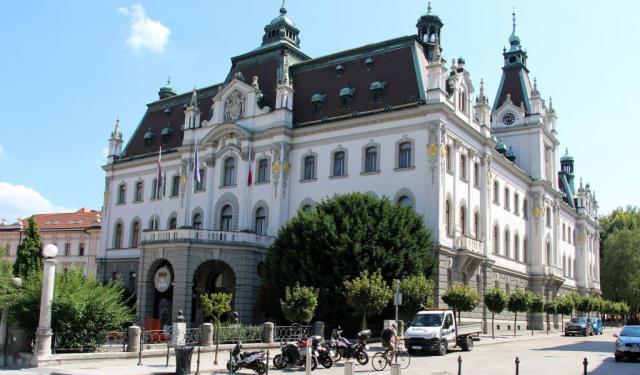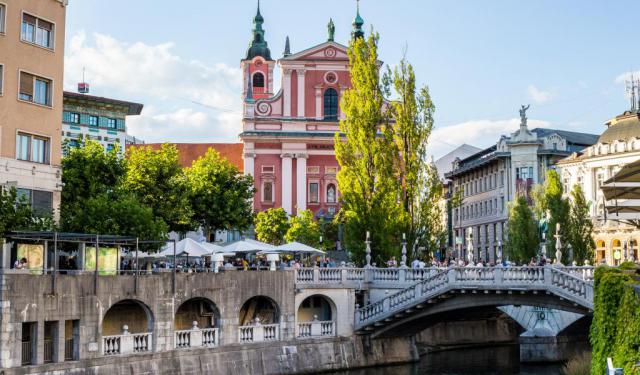
Narodna in univerzitetna knjiznica (National and University Library), Ljubljana
The National Library building, erected between 1936 and 1941, presents a striking appearance with its sleek brick exterior complemented by rugged stone layers that bring it to life. The whole ensemble is like something out of a fairy tale, intentionally reminiscent of its predecessor, a ducal palace destroyed by the 1895 earthquake, with its old stones woven into the new facade.
Regarded as one of Jože Plečnik's most monumental works, the building bears Italian influences and was conceived not as a palace proper but as a temple of knowledge, to be revered. Upon entering, visitors ascend a staircase from darkness into light, leading to the reading room. Both the staircase and grand entrance hall feature black limestone, resembling marble, sourced from the Slovenian Podpeč, symbolizing Plečnik's dedication to native materials. Reflecting his religious beliefs, a statue of Moses by sculptor Lojze Dolinar sits above the side entrance. On the whole, Plečnik's meticulous attention to detail is evident even in the smallest elements like doorknobs.
Initially facing resistance from Yugoslavian authorities in Belgrade, the project eventually gained traction thanks to persistent student protests and demonstrations, and by 1921, the National Library began acquiring legal deposit copies from across Yugoslavia.
Regarded as one of Jože Plečnik's most monumental works, the building bears Italian influences and was conceived not as a palace proper but as a temple of knowledge, to be revered. Upon entering, visitors ascend a staircase from darkness into light, leading to the reading room. Both the staircase and grand entrance hall feature black limestone, resembling marble, sourced from the Slovenian Podpeč, symbolizing Plečnik's dedication to native materials. Reflecting his religious beliefs, a statue of Moses by sculptor Lojze Dolinar sits above the side entrance. On the whole, Plečnik's meticulous attention to detail is evident even in the smallest elements like doorknobs.
Initially facing resistance from Yugoslavian authorities in Belgrade, the project eventually gained traction thanks to persistent student protests and demonstrations, and by 1921, the National Library began acquiring legal deposit copies from across Yugoslavia.
Want to visit this sight? Check out these Self-Guided Walking Tours in Ljubljana. Alternatively, you can download the mobile app "GPSmyCity: Walks in 1K+ Cities" from Apple App Store or Google Play Store. The app turns your mobile device to a personal tour guide and it works offline, so no data plan is needed when traveling abroad.
Narodna in univerzitetna knjiznica (National and University Library) on Map
Sight Name: Narodna in univerzitetna knjiznica (National and University Library)
Sight Location: Ljubljana, Slovenia (See walking tours in Ljubljana)
Sight Type: Attraction/Landmark
Guide(s) Containing This Sight:
Sight Location: Ljubljana, Slovenia (See walking tours in Ljubljana)
Sight Type: Attraction/Landmark
Guide(s) Containing This Sight:
Walking Tours in Ljubljana, Slovenia
Create Your Own Walk in Ljubljana
Creating your own self-guided walk in Ljubljana is easy and fun. Choose the city attractions that you want to see and a walk route map will be created just for you. You can even set your hotel as the start point of the walk.
Historic Buildings Walking Tour
The Slovenian capital has no shortage of historical buildings. The architectural wealth of Ljubljana accumulated over the years received a significant boost in the early 20th century thanks to the famous Slovenian architect, Joze Plecnik, a classicist, who tried to model the city on ancient Athens.
Among the notable local landmarks is the Ljubljana Central Pharmacy, a testament to the... view more
Tour Duration: 2 Hour(s)
Travel Distance: 2.8 Km or 1.7 Miles
Among the notable local landmarks is the Ljubljana Central Pharmacy, a testament to the... view more
Tour Duration: 2 Hour(s)
Travel Distance: 2.8 Km or 1.7 Miles
Ljubljana Introduction Walking Tour
Ljubljana is the capital and the heart of Slovenia. Being the country's cultural and political center, it is also Slovenia's largest city and has a long, storied past.
The exact origin of its name is not clear. Some linguists suggest that it may be rooted in "Ljubija," the original name of the Ljubljanica River derived from the Old Slavic male name "Ljubovid,"... view more
Tour Duration: 2 Hour(s)
Travel Distance: 2.0 Km or 1.2 Miles
The exact origin of its name is not clear. Some linguists suggest that it may be rooted in "Ljubija," the original name of the Ljubljanica River derived from the Old Slavic male name "Ljubovid,"... view more
Tour Duration: 2 Hour(s)
Travel Distance: 2.0 Km or 1.2 Miles


